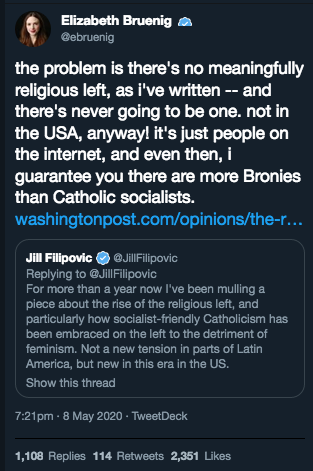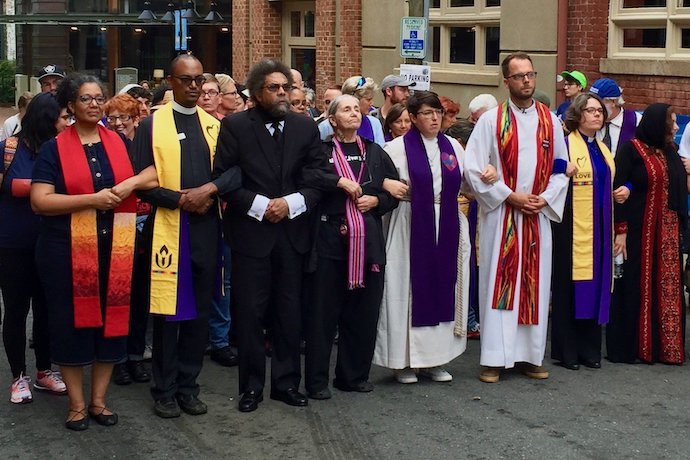Every time I write about debates on Twitter, I feel a bit like I’m reporting on an episode of The Real Housewives. But this one raises some substantial points that are worth considering, so here goes. Feminist writer Jill Filipovic wrote a quick appraisal of a New York Times Magazine article purportedly on the new rise of “punk” Christianity, which, I don’t know, isn’t particularly new (the author wrote on the same scene for RNS last year), but is supposed to save America or something? Anyway, Filipovic’s take is fair enough: just because something is hip doesn’t mean it’s liberal, and just because it’s liberal doesn’t mean it’s good on women’s issues. This is true! As Filipovic says,
https://twitter.com/JillFilipovic/status/1258781001494470661
But the fun really begins with the next tweet, where she continues,
For more than a year now I’ve been mulling a piece about the rise of the religious left, and particularly how socialist-friendly Catholicism has been embraced on the left to the detriment of feminism. Not a new tension in parts of Latin America, but new in this era in the US.
I’m not as familiar with this development as I should be, but interesting point. Some readers evidently took it as a veiled reference to Elizabeth Bruenig, who is a Bernie supporter, socialist, and pro-life, by her own description. It didn’t take long for the snitch-tweets to pop up alerting Bruenig, and then not long for Bruenig to respond in a now-deleted tweet:

Bruenig’s probably not wrong about there being more bronies than Catholic socialists: My Little Pony is very popular with a certain male demographic. On the other hand, Bruenig has a tendency to define “left” strictly in terms of socialist policies, dismissing everyone even slightly to the right of Sanders as “neoliberal.” As Jack Jenkins of Religion News Service demonstrated in a long thread, if you take a broader view, the religious left is very much more than “people on the internet,” including the Democratic Socialist icon Alexandra Ocasio-Cortez. And as many others, like Dana Houle, pointed out with varying degrees of sarcasm, Bruenig’s tweet ignored the substantial portion of the religious left that’s non-white, and/or not Christian.
I guess Elizabeth Bruenig isn’t aware of Jews or religious African-Americans or a lot of Muslim-Americans.
Or maybe she thinks to be leftist you had to have voted for Bernie, & to be religious you have to oppose abortion (or contraception?). pic.twitter.com/58icNAKghZ
— Dana Houle (@DanaHoule) May 9, 2020
I do have some small sympathy for Bruenig’s argument. After all, I too have said there’s not much of a religious left in the U.S. There really isn’t, if you mean a cohesive national movement advancing a unified policy agenda analogous to the Religious Right. That’s in fact why I never capitalize “religious left”: I don’t believe there’s a single entity you can point to. On a national level, we have what I’ve sometimes derided as the “Religion-Industrial Complex,” which specializes in amplifying religious left voices and coordinating their direct action (generous interpretation), or in a bunch of crap PR gambits (less generous interpretation). But there isn’t anything analogous to the interlocking religious think tanks, legal firms, and activist groups that make up the Religious Right.
Instead, the religious left is more decentralized. There are many state and regional groups, denominational policy offices, and single-issue groups that make up a loose coalition that despite the best efforts of the Religion-Industrial Complex, cheerfully and successfully resists just about anything in the way of central coordination. Jenkins sees this as a distributed movement, and likes to point to areas where it’s played a crucial role in progressive successes in recent years. (Some of his most interesting reporting has been about Indigenous religious activism around environmental concerns.)
I’ve taken a generally dimmer view, pointing to the ways in which the lack of cooperation has held the movement back nationally, and how its central concerns are routinely ignored in the corridors of power. I think it’s better to understand “the religious left” not as a movement so much as simply the people who make up the Democratic party and points left. In that sense, the religious left may be difficult to distinguish from the liberal-to-progressive spectrum in general, but it is very much alive and kicking.
Focusing too much on the organizational qualities of the religious left may obscure some of its important characteristics, however. To my mind, the more interesting question is whether the religious left can match the role of the Religious Right in defining and enforcing ideological orthodoxy. In some ways, no, they can’t, simply because of the right’s great advantage in uniformity. When your party agrees on pretty much everything, it makes it easier to all pull in the same direction. When the party is more diverse, it may be more beautiful, but it’s harder to get anything done.
But in some ways, they absolutely do, and this is where it becomes extremely important not to white out the diversity of the religious left. Who the religious left is may be more important than how it’s structured.
The two largest slices of the religious pie in the Democratic coalition belong to the unaffiliated (24%) and non-white Christians (36%). In all, white Christians only make up about a third of all Democrats. Of course there are more bronies than Catholic socialists: there aren’t that many Catholic socialists to begin with! Not white ones, anyway.
What there are, though, are secular folks who routinely take up the youngest and leftmost edges of the party, and black and Hispanic Christians, who can be quite progressive in their positions, but tend to be more pragmatic in their candidate selection. Between them, these groups create the limits that so frustrate Elizabeth Bruenig, because the secular voters are staunchly pro-choice, and the minority Christians might be pro-life, but they’re not at all interested in culture war or in socialist candidates.
Likewise, those two groups have increasingly helped to shape the course of the Democratic party over the past twenty years: firmly in favor of reproductive and racial justice, and significantly—but not radically—more progressive on economic issues. I hesitate to call this “orthodoxy,” but it is more or less settled opinion. Religiously unaffiliated voters and non-white Christians played more of a role in making it so than white Catholics, mainline Protestants, or evangelicals.
There are many open questions on the left these days, about whether the current American political system is sustainable, how best to address Trumpism, whether racial or economic approaches ought to be prioritized. These aren’t problems with easy solutions. It’s not surprising they spark a certain amount of friction. But it’s only with the most restrictive definition of the religious left that you can say it (or they) hasn’t helped set the course so far. You might not like where the Democratic party is these days, but let’s be clear: your beef isn’t with neoliberalism, it’s with the rank and file of the party, with the two-thirds who are Christian, and the substantial portion who are not. No amount of sniffing about the non-existence of the religious left can wave that away, and that’s coming from a guy who’s done quite a lot of sniffing about that very subject.


